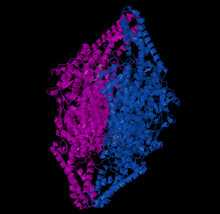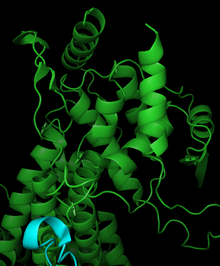Phenylalanine ammonia-lyase
| phenylalanine ammonia-lyase | |||||||||
|---|---|---|---|---|---|---|---|---|---|
 PDB rendering based on 1T6J. | |||||||||
| Identifiers | |||||||||
| EC number | 4.3.1.24 | ||||||||
| CAS number | 9024-28-6 | ||||||||
| Databases | |||||||||
| IntEnz | IntEnz view | ||||||||
| BRENDA | BRENDA entry | ||||||||
| ExPASy | NiceZyme view | ||||||||
| KEGG | KEGG entry | ||||||||
| MetaCyc | metabolic pathway | ||||||||
| PRIAM | profile | ||||||||
| PDB structures | RCSB PDB PDBe PDBsum | ||||||||
| Gene Ontology | AmiGO / EGO | ||||||||
| |||||||||
Phenylalanine ammonia lyase (EC 4.3.1.24) is an enzyme that catalyzes a reaction converting L-phenylalanine to ammonia and trans-cinnamic acid.[1] Phenylalanine ammonia lyase (PAL) is the first and committed step in the phenyl propanoid pathway and is therefore involved in the biosynthesis of the polyphenol compounds such as flavonoids, phenylpropanoids, and lignin in plants.[2][3] Phenylalanine ammonia lyase is found widely in plants, as well as some yeast and fungi, with isoenzymes existing within many different species. It has a molecular mass in the range of 270-330 kDa.[1][4] The activity of PAL is induced dramatically in response to various stimuli such as tissue wounding, pathogenic attack, light, low temperatures, and hormones.[1][5] PAL has recently been studied for possible therapeutic benefits in humans afflicted with phenylketonuria.[6] It has also been used in the generation of L-phenylalanine as precursor of the sweetener aspartame.[7]
The enzyme is a member of the ammonia lyase family, which cleaves carbon-nitrogen bonds. Like other lyases, phenylalanine requires only one substrate for the forward reaction, but two for the reverse. It is thought to be mechanistically similar to the related enzyme histidine ammonia-lyase (EC:4.3.1.3, HAL).[8] The systematic name of this enzyme class is L-phenylalanine ammonia-lyase (trans-cinnamate-forming). Previously, it was designated EC 4.3.1.5, but that class has been redesignated as EC 4.3.1.24 (phenylalanine ammonia-lyases), EC 4.3.1.25 (tyrosine ammonia-lyases), and EC 4.3.1.26 (phenylalanine/tyrosine ammonia-lyases). Other names in common use include tyrase, phenylalanine deaminase, tyrosine ammonia-lyase, L-tyrosine ammonia-lyase, phenylalanine ammonium-lyase, PAL, and L-phenylalanine ammonia-lyase.
Enzyme Mechanism
Phenylalanine ammonia lyase is specific for L-Phe, and to a lesser extent, L-Tyrosine.[9][10] The reaction catalyzed by PAL is the spontaneous, non-oxidative deamination of L-phenylalanine to yield trans-cinnamic acid and ammonia.[11]
- L-phenylalanine trans-cinnamate + NH3
The cofactor 3,5-dihydro-5-methyldiene-4H-imidazol-4-one (MIO) is involved in the reaction and sits atop the positive pole of three polar helices in the active site, which helps to increase its electrophilicity.[12] MIO is reported to attack the aromatic ring of L-Phe in a Friedel-Crafts-type reaction, which activates the C-H bond and leads to cleavage of the bond.[13] The carbanionintermediate formed by this mechanism is stabilized by partial positive regions in the active site. The mechanism of the reaction of PAL is thought to be similar to the mechanism of the related enzyme histidine ammonia lyase.[13] PAL is inhibited by trans-cinnamic acid, and, in some species, may be inhibited trans-cinnamic acid derivatives.[1][14] D-Phe and D-Tyr are competitive inhibitors.[9]
Enzyme Structure

Phenylalanine ammonia lyase is composed of four identical subunits composed mainly of alpha-helices, with pairs of monomers forming a single active site.[15] Catalysis in PAL may be governed by the dipole moments of seven different alpha helices associated with the active site.[16] The active site contains the electrophilic group MIO non-covalently bonded to three helices. Leu266, Asn270, Val269, Leu215, Lys486, and Ile472 are located on the active site helices, while Phe413, Glu496, and Gln500 contribute to the stabilization of the MIO cofactor. The orientation of dipole moments generated by helices within the active site generates an electropositive region for ideal reactivity with MIO. The partially positive regions in the active site may also help stabilize the charge of a carbanion intermediate. PAL is structurally similar to the mechanistically related histidine ammonia lyase, although PAL has approximately 215 additional residues.[15]
Biological Function
Phenylalanine ammonia lyase can perform different functions in different species. It is found mainly in some plants and fungi (i.e. yeast). In fungal and yeast cells, PAL plays an important catabolic role, generating carbon and nitrogen.[2] In plants it is a key biosynthetic enzyme that catalyzes the first step in the synthesis of a variety of polyphenyl compounds [2][3] and is mainly involved in defense mechanisms. PAL is involved in 5 metabolic pathways: tyrosine metabolism, phenylalanine metabolism, nitrogen metabolism, phenylpropanoid biosynthesis, and alkaloid biosynthesis ii.
Disease Relevance
Researchers are exploring enzyme substitution therapy using PAL to treat phenylketonuria (PKU), an autosomal recessive genetic disorder in humans in which mutations in the phenylalanine hydroxylase (PAH, EC 1.14.16.1) gene inactivate the enzyme.[6] This leads to an inability of the patient to metabolize phenylalanine, causing elevated levels of Phe in the bloodstream (hyperphenylalaninemia) and mental retardation if therapy is not begun at birth.[6] Treatment in mouse models using recombinant PAL has been shown to lower plasma Phe level, converting L-Phe to harmless metabolites that can be excreted. In order to reduce the immunogenicity of PAL, the enzyme is modified by PEGylation. This process disguises the introduced PAL from the host’s immune system and can lead to a longer and more effective reduction in blood Phe levels than non-modified PAL.[17]
Current treatment for PKU requires patients to adhere to a specific diet their whole life, which can be difficult to maintain and may contribute to birth defects if pregnant patients are not careful enough.[18] Therefore, continued research into the development of enzyme therapy using PAL is of interest for the medical community.
PAL may also be used in the treatment of certain forms of mouse neoplastic tumors.[2]
Industrial Relevance
Artificial Sweeteners
The reverse reaction catalyzed by PAL has been used to convert trans-cinnamic acid to L-phenylalanine, which is a precursor of the sweetener aspartame. This process was developed by Genex Corporation in the USA using yeast Rhodotorula cells (U.S. Patent 4,574,117; U.S. Patent 4,584,269; U.S. Patent 4,584,273; U.S. Patent 4,598,047; U.S. Patent 4,636,466; U.S. Patent 4,681,850; U.S. Patent 4,757,015).[7]
Unnatural Amino Acid Synthesis
Analogous to how aspartame is synthesized, PAL is also used to synthesize unnatural amino acids from various substituted cinnamic acids for research purposes.[19] Steric hindrance from arene substitution limits PAL's utility for this purpose however.[20] For instance, when Rhodotorula glutinis was used to affect this biotransformation the enzyme was discovered to be intolerant of all para substituents other than fluoride analogs, presumably due to the element's small atomic radius. Meta and ortho positions were found to be more tolerant, but still limited by, larger substituents. For instance the enzyme's active site permitted methoxy substitution but forbid ethoxy. Other organisms with different versions of the enzyme may be less limited in this way.[21][22]
Structural studies
As of late 2007, 5 structures have been solved for this class of enzymes, with PDB accession codes 1T6J, 1T6P, 1W27, 1Y2M, and 2NYF.
References
- 1 2 3 4 Camm, Edith L.; Towers, G.H.Neil (1 May 1973). "Phenylalanine ammonia lyase". Phytochemistry. 12 (5): 961–973. doi:10.1016/0031-9422(73)85001-0.
- 1 2 3 4 Fritz, RR; Hodgins, DS; Abell, CW (Aug 10, 1976). "Phenylalanine ammonia-lyase. Induction and purification from yeast and clearance in mammals.". The Journal of Biological Chemistry. 251 (15): 4646–50. PMID 985816.
- 1 2 Tanaka, Y; Matsuoka, M; Yamanoto, N; Ohashi, Y; Kano-Murakami, Y; Ozeki, Y (August 1989). "Structure and characterization of a cDNA clone for phenylalanine ammonia-lyase from cut-injured roots of sweet potato.". Plant Physiology. 90 (4): 1403–7. doi:10.1104/pp.90.4.1403. PMID 16666943.
- ↑ Appert, C; Logemann, E; Hahlbrock, K; Schmid, J; Amrhein, N (Oct 1, 1994). "Structural and catalytic properties of the four phenylalanine ammonia-lyase isoenzymes from parsley (Petroselinum crispum Nym.).". European Journal of Biochemistry / FEBS. 225 (1): 491–9. doi:10.1111/j.1432-1033.1994.00491.x. PMID 7925471.
- ↑ Hahlbrock, K; Grisebach, H (1 June 1979). "Enzymic Controls in the Biosynthesis of Lignin and Flavonoids". Annual Review of Plant Physiology. 30 (1): 105–130. doi:10.1146/annurev.pp.30.060179.000541.
- 1 2 3 Sarkissian, Christineh N.; Gámez, Alejandra (1 December 2005). "Phenylalanine ammonia lyase, enzyme substitution therapy for phenylketonuria, where are we now?". Molecular Genetics and Metabolism. 86: 22–26. doi:10.1016/j.ymgme.2005.06.016.
- 1 2 Evans, ChristopherT.; Hanna, Kim; Conrad, Dayle; Peterson, Wendy; Misawa, Masanaru (1 February 1987). "Production of phenylalanine ammonia-lyase (PAL): isolation and evaluation of yeast strains suitable for commercial production of l-phenylalanine". Applied Microbiology and Biotechnology. 25 (5). doi:10.1007/BF00253309.
- ↑ Schwede, TF; Rétey, J; Schulz, GE (Apr 27, 1999). "Crystal structure of histidine ammonia-lyase revealing a novel polypeptide modification as the catalytic electrophile.". Biochemistry. 38 (17): 5355–61. doi:10.1021/bi982929q. PMID 10220322.
- 1 2 Hodgins, DS (May 10, 1971). "Yeast phenylalanine ammonia-lyase. Purification, properties, and the identification of catalytically essential dehydroalanine.". The Journal of Biological Chemistry. 246 (9): 2977–85. PMID 5102931.
- ↑ Barros, J.; Serrani-Yarce, J.C.; Chen, F.; Baxter, D.; Venables, B.J.; Dixon, R.A. (2016). "Role of bifunctional ammonia-lyase in grass cell wall biosynthesis". Nat. Plants. 2: 16050. doi:10.1038/nplants.2016.50. PMID 27255834.
- ↑ KOUKOL, J; CONN, EE (October 1961). "The metabolism of aromatic compounds in higher plants. IV. Purification and properties of the phenylalanine deaminase of Hordeum vulgare.". The Journal of Biological Chemistry. 236: 2692–8. PMID 14458851.
- ↑ Alunni, S; Cipiciani, A; Fioroni, G; Ottavi, L (Apr 15, 2003). "Mechanisms of inhibition of phenylalanine ammonia-lyase by phenol inhibitors and phenol/glycine synergistic inhibitors.". Archives of Biochemistry and Biophysics. 412 (2): 170–5. doi:10.1016/s0003-9861(03)00007-9. PMID 12667480.
- 1 2 Langer, B; Langer, M; Rétey, J (2001). "Methylidene-imidazolone (MIO) from histidine and phenylalanine ammonia-lyase.". Advances in protein chemistry. 58: 175–214. doi:10.1016/s0065-3233(01)58005-5. PMID 11665488.
- ↑ Sato, Toshitsugu; Kiuchi, Fumiyuki; Sankawa, Ushio (1 January 1982). "Inhibition of phenylalanine ammonia-lyase by cinnamic acid derivatives and related compounds". Phytochemistry. 21 (4): 845–850. doi:10.1016/0031-9422(82)80077-0.
- 1 2 Calabrese, JC; Jordan, DB; Boodhoo, A; Sariaslani, S; Vannelli, T (Sep 14, 2004). "Crystal structure of phenylalanine ammonia lyase: multiple helix dipoles implicated in catalysis.". Biochemistry. 43 (36): 11403–16. doi:10.1021/bi049053+. PMID 15350127.
- ↑ Pilbák, S; Tomin, A; Rétey, J; Poppe, L (March 2006). "The essential tyrosine-containing loop conformation and the role of the C-terminal multi-helix region in eukaryotic phenylalanine ammonia-lyases.". The FEBS Journal. 273 (5): 1004–19. doi:10.1111/j.1742-4658.2006.05127.x. PMID 16478474.
- ↑ Gámez, A; Wang, L; Straub, M; Patch, MG; Stevens, RC (January 2004). "Toward PKU enzyme replacement therapy: PEGylation with activity retention for three forms of recombinant phenylalanine hydroxylase.". Molecular therapy : the journal of the American Society of Gene Therapy. 9 (1): 124–9. doi:10.1016/j.ymthe.2003.11.002. PMID 14741785.
- ↑ Lenke, RR; Levy, HL (Mar 1, 1982). "Maternal phenylketonuria--results of dietary therapy.". American Journal of Obstetrics and Gynecology. 142 (5): 548–53. PMID 7058857.
- ↑ Hughes, Andrew (2009). Amino Acids, Peptides and Proteins in Organic Chemistry Volume 1. Weinheim Germany: Wiley VCH. p. 94. ISBN 9783527320967.
- ↑ Renard, G; Guilleux, J; Bore, C; Malta-Valette, V; Lerner, D (1992). "Synthesis of L-phenylalanine analogs by Rhodotorula glutinis. Bioconversion of cinnamic acids derivatives". Biotechnology Letters. 14 (8): 673–678. doi:10.1007/BF01021641.
- ↑ Lovelock, Sarah L.; Turner, Nicholas J. (2014). "Bacterial Anabaena variabilis phenylalanine ammonia lyase: A biocatalyst with broad substrate specificity". Bioorganic & Medicinal Chemistry. 22 (20): 5555–5557. doi:10.1016/j.bmc.2014.06.035. PMID 25037641.
- ↑ Showa, Denko; Hirobumi, Aoki. "Production process of l-phenylalanine derivatives by microorganisms". Google Patents. Hirobumi Central Research Laboratory. Retrieved 20 July 2014.
- KOUKOL J, CONN EE (1961). "The metabolism of aromatic compounds in higher plants. IV Purification and properties of the phenylalanine deaminase of Hordeum vulgare" (PDF). J. Biol. Chem. 236 (10): 2692–8. PMID 14458851. Retrieved November 25, 2010.
- Young MR; Neish AC (1966). "Properties of the ammonia-lyases deaminating phenylalanine and related compounds in Triticum sestivum and Pteridium aquilinum". Phytochemistry. 5 (6): 1121–1132. doi:10.1016/S0031-9422(00)86105-1.